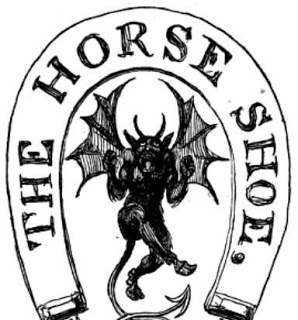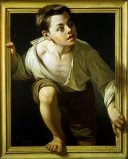Who in the devil came up with this topic “horseshoes?” What am I supposed to do with it? I know that people for generations have tossed horseshoes at metal stakes as a game. My dad used to many years ago. Washington Park even included a brand new horseshoe pitch as part of recent renovation. Apparently, my great-grandfather was a skilled farrier, although I heard mention of it only once. I am not an equestrian nor a Western cowboy, so I don’t hang around horses or blacksmiths.
It seems that we non-rural folks occasionally use the odd horseshoe or two as decoration, sometimes nailing them over doors for supposed good luck. I’m told that the shoe must point up; otherwise, all the good luck will run out. So, how did that old custom of good-luck horseshoes come about? Apparently, the horseshoes keep the Devil and witches away.
Some say that the horseshoe legend goes back as far as the year 969 CE when a blacksmith named Dunstin supposedly was visited by the Devil. The visitor surprised Dunstin by requesting that he have horseshoes nailed to his feet. Dunstin was even more surprised to discover that, rather than feet, the individual had cloven hooves. Apparently, this was a dead give-away that this was not a man but, instead, the Devil himself. Dunstin quickly stated that the individual had to be placed in the oxen-lift and hoisted up in order to do the shoeing. This was agreed to, and Dunstin began his labors, deliberately making the process as prolonged and as painful as possible. Howling in pain, the Devil pleaded to cease the shoeing.
Dunstin promised to let the Devil go but with one condition, that any home with a horseshoe nailed to a wall or over a doorway was off limits to the Devil. He could not harm anyone living in or visiting that place. The Devil agreed and was released.
The historically known Dunstin became the Archbishop of Canterbury. It is said that Christians were the first to move the horseshoes down onto the center of their front and back doors to be used as doorknockers. The knock of iron on wood was thought to ward away the devil and awaken guardian angels. So, it’s advisable to have a good pair of knockers.
Legend has it that displayed horseshoes also could keep witches away. Of course in this case, we are not talking about the anthropologically accurate nature of these pre-Christian pagans. Historically, they did not believe in, nor engage in, evil. Instead, the later misrepresentation and popular portrayal of evil, old hags is addressed here.
There is a 1666 legend concerning a Goody Chandler of Newbury, Massachusetts, who claimed that her illness was caused by her very unpopular neighbor Elizabeth Morse. Once a horseshoe was nailed above the door, supposedly Elizabeth could not enter the house.
The story goes on to say that her nosy, fundamentalist neighbor William Moody removed the horseshoe, stating that he was opposed to any kind of magic, that it was just as bad as witchcraft. I know how religiously uptight some people can be. My mother’s ancestors are of Puritan stock, arriving here in 1630 with Governor Winthrop; and I suspect that they may have participated in hanging a couple of witches in Salem. Not straying outside the Bible was the official platform of the Puritan church in New England. Cotton Mather wrote in Wonders of the Invisible World that, “The Children of New-England have Secretly done many things that have been pleasing to the Devil. They say, That in some Towns, it ha’s been an usual Thing for People to Cure Hurts with Spells, or to use Detestable Conjurations, with Sieves, & Keyes, and Pease, and Nails, and Horse-Shooes… ‘Tis in the Devils Name that such Things are done.”
Removing the horseshoe from above the door was followed by renewed visits by Elizabeth, whereupon, Goody became worse and eventually died. I am sure that this tale is apocryphal, but it does reflect the mindset of the time.
A horseshoe could also be used to keep a dead witch in her grave. The towns-people of Hampton, New Hampshire, staked the heart of suspected witch Goody Cole after she died. They tied a horseshoe to the stake. Perhaps it was because of the iron, believing that supernatural creatures such as witches fear iron. In the British Isles, witches often were accused of associating with fairies, so peasants nailed horseshoes over their doors to keep fairies out of the house. I was quick to notice that there is no horseshoe nailed over the door here. What would happen if there were? Oh well, as an old Celtic blessing says. “May the charm and good luck of the horseshoe be with you and yours always!”
About the Author
I have had a life-long fascination with people and their life stories. I also realize that, although my own life has not brought me particular fame or fortune, I too have had some noteworthy experiences and, at times, unusual ones. Since I joined this Story Time group, I have derived pleasure and satisfaction participating in the group. I do put some thought and effort into my stories, and I hope that you find them interesting.

